Fascia Exercises Are the 10-Minute Routine Helping Women Get One Size Smaller — Fast!
For years, if we wanted to drop a couple pant sizes, we might look for answers on the worldwide web. But cutting-edge science now points to another web — inside our body — that holds keys to easily tame bloat and trim inches. Huh? We’re talking about fascia, the web of connective tissue that runs under the skin and plays a vital role in everything from pain management to weight loss. It’s even been compared to “inner Spanx” for its ability to change our body shape. What's more, fascia exercises can help you lose weight. Keep reading for all the details.
Why does fascia matter?
Damaged fascia can affect the body in conditions like plantar fasciitis or frozen shoulder. “Doctors call it ’50s Shoulder’ because it is so common in women going through menopause,” says Antonio Stecco, MD, PhD, a leading expert in fascia biomechanics and rehabilitation medicine. He explains, “Research tells you that 87% of people will have myofascial pain at least once in their life, but I think it is much more!”
MUST-READ: Yoga for Menopause Helps Tame Hot Flashes, Irritability, Fatigue and More, Experts Agree
Historically, fascia wasn’t on most traditional doctors’ radar. Then around 2007, this tissue started getting attention. That’s when Italian research proved fascia is filled with nerves: 250 million nerve endings. Dr. Stecco says, “That’s way more than in tendons or ligaments.” Suddenly, doctors started calling fascia “the Wi-Fi of the body” for its unrivaled ability to communicate with all other body systems. It’s also known as our “sixth sense.” And Harvard University even launched a conference on fascia medicine.
Fascia’s communication pathways helped explain why practices like acupressure, which have been trusted for thousands of years, deliver such impressive results. Dr. Stecco notes, “We say fascia is the connective tissue that connects East and West medicine.”
“Now we know fascia touches every cell in our body. It’s a quantum information highway,” says fascia practitioner Lauren Roxburgh, aka “The Body Whisperer.” She says, “This research confirms what I have felt over my two decades of hands-on study.”
MUST-READ: The Atlantic Diet May Be the Healthiest Diet Ever: What You Need to Know
The fascia/weight connection
Fascia contains receptors for progesterone and estrogen. And when levels of those hormones dip with age, it makes fascia stiff. So right when we start to gain frustrating menopausal weight, we feel too sore to try to exercise it off. And when fascia is unhealthy, it becomes dense. Things like chronic stress, toxins, injury or age can create scar-like blockages that trigger pain, restrict motion and affect posture, making us appear wider and heavier. Roxburgh adds, “Unhealthy fascia holds on to cellular waste and hampers our metabolism.”
What’s more: Old emotions and traumas are thought to get “trapped” in fascia. And when our nervous system is stuck in fight-or-flight mode, our body can’t drop weight. Roxburgh explains, “The old model of trying to lose weight — counting calories or starving yourself — disconnected you from your instincts and body intelligence.” But by tapping into fascia’s network, we develop a greater ability to interpret internal signals like hunger to control food cravings. Roxburgh adds, “When we start to work with our fascia, we tell our nervous system to go into rest, digest and heal mode.”
Roxburgh, 45, author of Taller, Slimmer, Younger, is living proof that fascia can heal quickly and speed weight loss. Years ago, she carried extra pounds and anger (from her mother’s cancer battle and her own divorce). Then she started massaging and stretching her fascia to ease her pain and stiffness. She shares, “It was an epiphany.” Those movements helped her release tension and improve mobility. That’s not all. “I lost 20 pounds.” She says, “Foam rolling for 10 minutes per day completely transformed my body.”
MUST-READ: Top MDs Reveal the 10 Best Foods to Eat For Gut Health
How to keep fascia healthy
Research shows that using tools like a foam roller to stimulate fascia boosted metabolism so subjects burned 168 more calories per day, without changing exercise routines. Plus, people working on their fascia for just 4 weeks had 54% higher levels of irisin, which experts call the “exercise hormone” for its ability to convert lumpy white fat cells into easily melted thermogenic brown fat cells.
With this wisdom, Roxburgh created a 21-day exercise program that utilizes easy foam roller moves to smooth out fascia and melt away stubborn inches. “When you realign your bone structure, you get taller and less compressed. All of a sudden, your body starts to shed the excess fat, lymph toxins or trapped hormones,” says Roxburgh. “You actually become more narrow and your digestion and metabolism start working better.”
Roxburgh has seen many women improve posture and gain 11?2 inches in height this way. One client lost 3 inches in her hips in three weeks.
Focusing on fascia can also ease pain. Just ask Gai Russo, who transformed her body and eliminated her pain in her 50s. She says, “Fascia is an untapped organ that we need to use more effectively.” Turn the page to try Roxburgh’s slimming foam roller moves for yourself…
Eat foods that support fascia health

Eating meals inspired by Mediterranean, paleo or plant-based diets naturally support fascia health. Specifically, research suggests eating foods rich in protein, antioxidants, minerals and vitamins can repair and heals fascia tissue. Here, Roxburgh’s top picks:
Protein: Fish, eggs, bone broth, yogurt and kefir
Vitamins: Avocado, berries, citrus, tomatoes, leafy greens and extra-virgin olive oil
Minerals: Almonds, cashews, spirulina, oysters
Fiber: Hard squashes, beans, chia seeds
Optimizing your body’s fascia, which Lauren Roxburgh calls the “intelligent web within,” is a surefire way to support lymphatic flow to flush cellular waste and banish bloat and water weight. It also improves long-term metabolism. (Click to learn more about the lymphatic diet.)
Even if your body feels stiff, sluggish or heavy now, it can change. “Fascia is the most malleable system of the body,” assures Roxburgh. “It’s about getting flow in the tissues and organs, decompressing the joints, improving alignment and then reconnecting to the specific muscles that support and ultimately pull in the waist, which combats the compression and thickening we experience as we age.”
“After 21 days, I promise you will notice a difference in your body shape,” says Roxburgh, who teaches women to use foam rollers to “melt down and hydrate the fascia, thus releasing toxins…getting rid of scar tissue and clearing out body blockages.” She advises thinking about fascia exercises as a “non-negotiable thing you do every day like brushing your teeth.” Get a taste of her “anti-workout workout” with the sample moves to the right. For even better results, incorporate the bonus tips below:
Fascia exercises: Walk for 40 minutes
The lymph nodes are located in fascia, so a daily walk can pump fluid through the lymphatic channels, stimulating both slimming systems. As you step, try adding in transverse motion by rotating your ribs opposite to your hips. “This establishes length in your sides, wrings out the internal organs and creates freedom for your lungs,” explains Roxburgh. “You’re working your core, standing taller, feeling more confident and looking more youthful.”
Related: Study: Slow Walking Actually Helps Women Over 50 Boost Weight Loss + Burn Fat Faster
Fascia exercises: Jump for 10 minutes
Jumping on a mini trampoline keeps fascia supple and healthy. NASA research shows that bouncing for 10 minutes a day burns more calories than 30 minutes of running, without the strain, plus it burns 68% more fat and delivers greater cardiovascular benefits. (Click through to see how jumping rope helped one woman lose weight.)
To learn more: Download Lauren Roxburgh’s FREE Body Reset Guide to learn more ways to support your fascia.
Your Taller and Slimmer Mini Plan
Start with a 36"-long foam roller (available on Amazon). Opt for one that’s firm — not too soft or too hard. Practice the foam roller moves below for 10 minutes a day, breathing deeply to de-stress.
1. Fascia exercises: Upper back roll

(A) Using your feet to drive the motion, inhale as you roll up to massage the upper back and shoulder blades, stopping at the base of the neck.
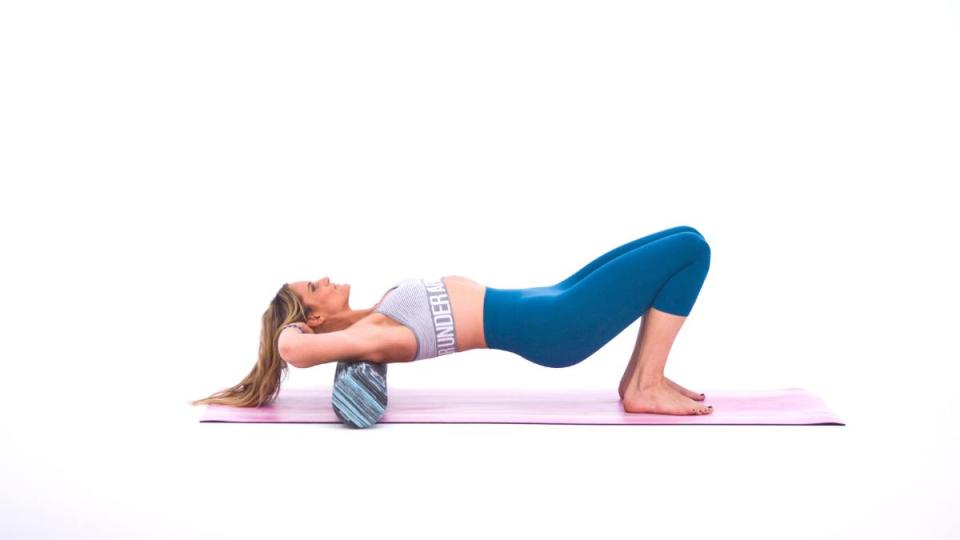
(B) Exhale as you roll back down the spine, stopping at the bottom of your rib cage. (Avoid the sensitive lower-back area.) Repeat 8 times.
2. Fascia exercises: Snow angels
This move opens the chest to keep shoulders, back and neck elegant. Lie on the roller parallel to your body, your spine supported from head to tailbone.
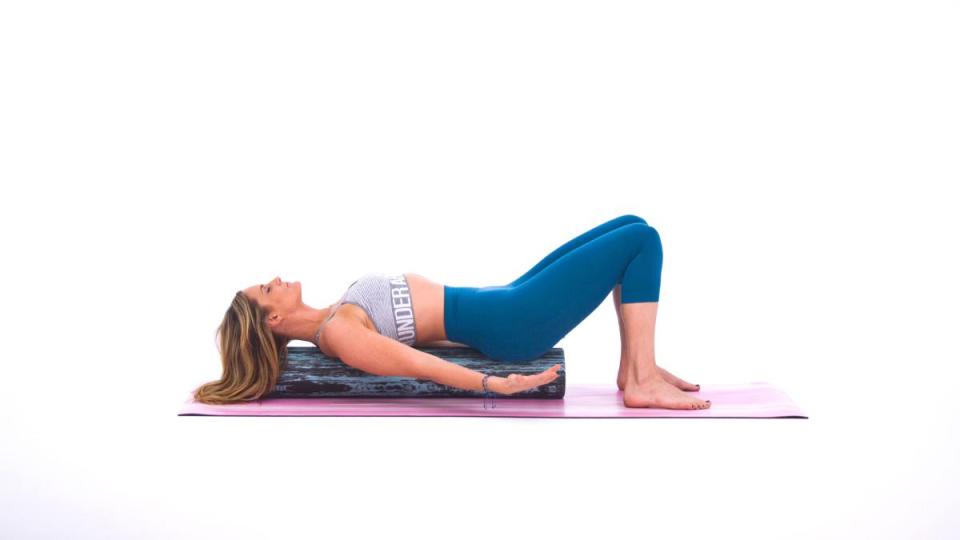
(A) Start with arms extended down by your sides, palms up. Inhale deeply and slowly reach your arms out to the side, staying parallel to the floor.
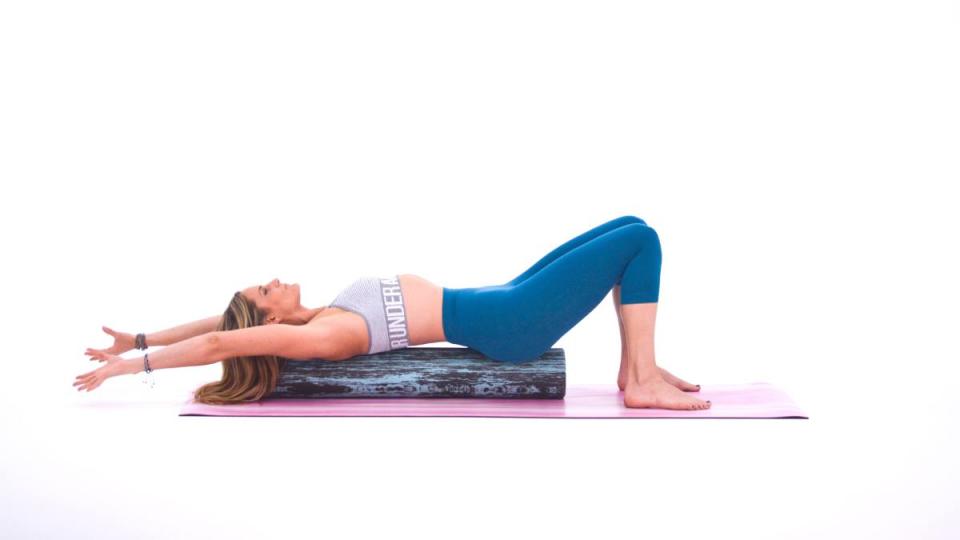
(B) Continue sweeping arms up overhead, moving as close to the floor as possible. Exhale as you draw your arms back down to your sides. Repeat 8 times.
3. Fascia exercises: Inverted core lift
This move tones and sculpts the waist and core. Lie down with the roller arranged under your tailbone. Keep your shoulders and upper back on the floor. Use your hands to hold the ends of the roller securely in place.
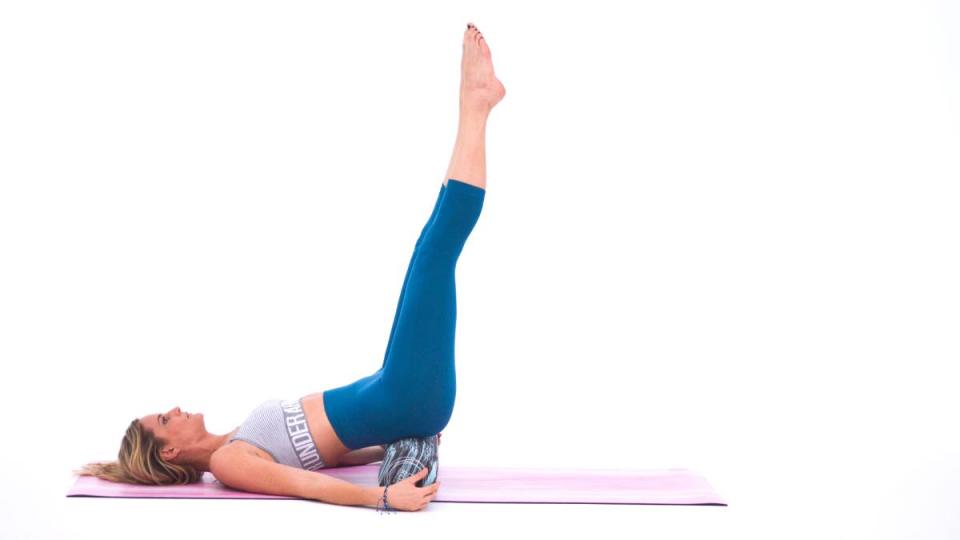
(A) Inhale as you elevate and extend your legs to about a 90-degree angle so they’re pointing up to the ceiling. Keep your spine stable and neutral for the whole of this exercise.
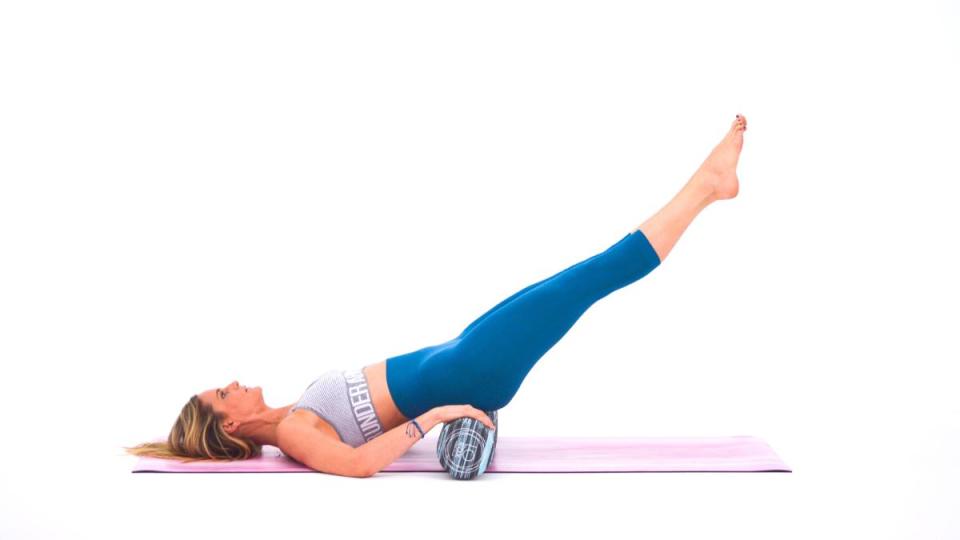
(B) Exhale as you slowly lower your legs. Bring them as low as you can without arching your lower back. Then use your deep lower back to draw your legs back up toward the ceiling to the start point. Repeat 8 times.
4. Fascia exercises: Bridge
This move lifts and shapes the bottom. Lie on your back, bend your knees and arrange the roller under the balls of your feet, keeping feet parallel. Rest your arms long and flat by your sides.
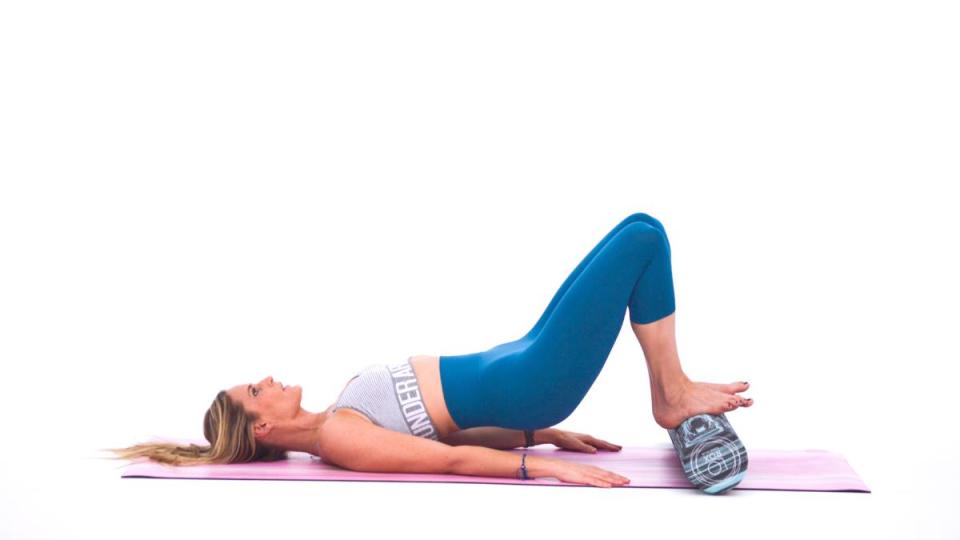
(A) Keeping the roller stable, inhale as you begin to lift your spine one vertebra (or inch) at a time while holding in your belly. Exhale up to a straight spine bridge position.
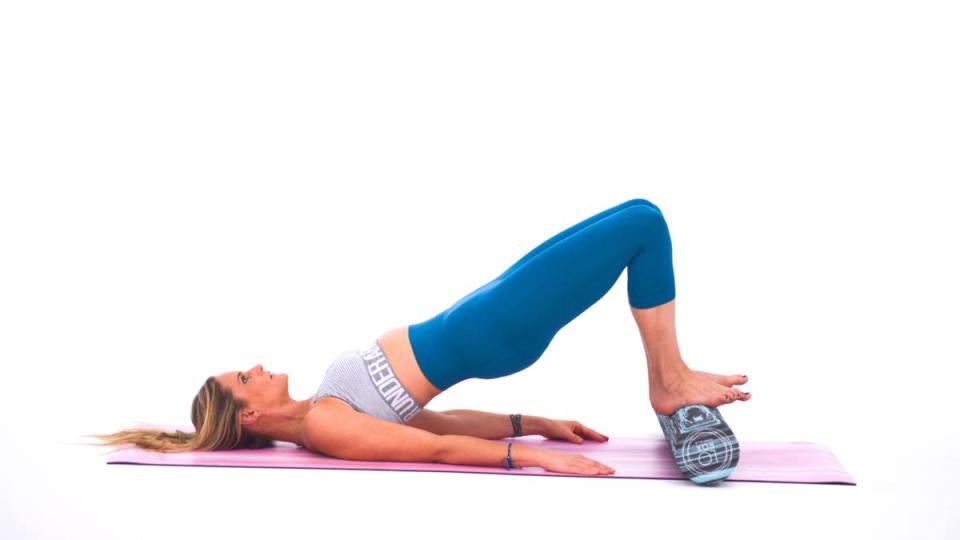
(B) Slowly lower back down to the starting point, inhaling and exhaling as you do. Repeat 8 times.
Fascia exercises success story: Gai Russo, 58
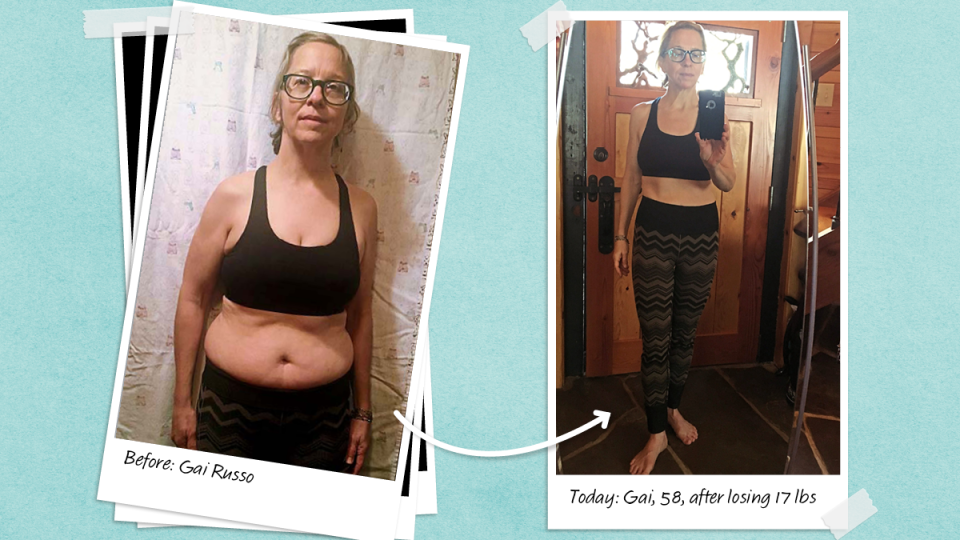
Gai Russo had been waking up in the night with chronic hip pain. She admits, “I was taking Advil like candy” — taking 4 to 6 of the pain relievers a day for several days every month.” But she wasn’t sure how to improve her pain and mobility.
Then Gai learned about Lauren Roxburgh’s foam rolling program. She gave the moves a try and started eating plant-based meals, like spinach smoothies, lentil stew and healthy blueberry cheesecake, to support her fascia health. She also focused on breathing deeply, walking and jumping on a rebounder.
Gai watched as bloat and fluid trapped in her abdomen disappeared. It wasn’t lost on Gai that she’d been holding a lot of “sadness” and trauma in that region—from past miscarriages and ectopic pregnancies. When she easily lost 17 pounds in 10 weeks, she says, “I was shocked. I went down two sizes at least!”
Gai stuck with the routine and within 6 months she no longer needed any pain meds. And when she went for her annual physical, she learned she’s gained an inch in height. “My posture changed because the fascia around my spine was no longer bunched up.” She shares, “This practice really made me aware of my body intelligence. I had no idea I had this power and could wake it up.”
Today, the artist and jewelry maker, who is always hammering or constructing something, says, “these tools help me stay limber and mobile.” In fact, she’d completed ten, 10-week foam roller challenges. “It was so worth it. I haven’t taken Advil for 6 years,” she says. “I feel like I’m in my 30s!”
This content is not a substitute for professional medical advice or diagnosis. Always consult your physician before pursuing any treatment plan.
